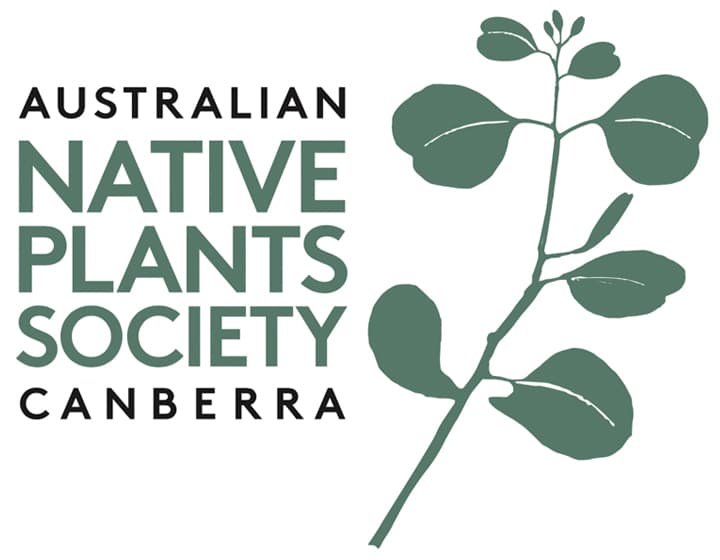That Was the Summer that Was
By Nola McKeon and Lyndal Thorburn
March 2021
Introduction
The summer of 2020, spanning December 2019 to the end of February 2020, was one to remember, and not because of COVID-19, which was only just starting to hit by the end of that season. The summer was memorable because of the pall of smoke that hung over Canberra and its surrounding region and caused by the terrible bush fires that ravaged NSW through spring and summer, until it rained in February.
The summer was exceptionally hot, with many days over 40 degrees Celsius, and it was also abnormally dry — we received only 97mm of rain the whole season (including the 60mm that fell on the tenth of January). This was only 60% of the long-term average falling at Canberra Airport, according to the Bureau of Meteorology.
Our gardens suffered!
While we were all grateful for the change in weather that La Nina brought from February onwards, we know that summers of the future are likely to be drier and hotter than average. So ANPS Canberra Region Council decided to commission a survey of members, before the memories of THAT summer fade any further, to glean what lessons we can from our experiences. The focus of the survey was the effect of both lack of rain and excess heat on our plants and on our gardening behaviours (watering etc) and whether those experiences have changed our future gardening practices. Council also hoped that there might be some broader lessons about which genera of Australian native plants are better suited for our increasingly dry climate.
Approval for the survey, Drought and Heat Hardiness Plant Survey, was given in September. It was run in January 2021, after testing a draft with a handful of members during October/November 2020. Fifty-two members responded to the survey — a great turnout, over 18% of membership. Of the respondents, 46% gardened on clay soils, 14% on Eucalypt-based soils (water-repellent), 14% on stony soils, 9% on red or yellow earths and the remainder on ‘other’. Thirty one percent (31%) of respondents reported that their gardens had northerly aspect, 50% reported multiple aspects, 6% reported easterly aspect, and 13% reported south or westerly aspect (13%).
This report summarises their responses to our survey questions.
What is Normal?
The first questions of the survey asked about members’ ‘normal’ watering regimes for their gardens in summer (that is, a summer other than the one we had in 2020), focusing on plants growing in the ground. Forty five percent (45%) of respondents reported that they watered individual plant as required, rather than watering the whole garden. Of the 55% who watered the whole garden, the main approach was to water approximately weekly (18% of the total sample). When we come to 2020, the answers were very similar, meaning that few people changed their watering regimes. There was a slight increase in the percent of respondents watering specific plants as needed, countered by a very slight reduction in respondents watering monthly or fortnightly (see Table).

Which genera?
Respondents were asked about the amount of additional water they had to provide a set of common genera in 2020 to keep them alive. It is recognised that location and age of plants in a garden play a big role in survival, but with this limited survey it wasn’t possible to explore this in detail. Respondents were simply asked how often they had to water genera as a whole in 2020. The options were watering daily, weekly, monthly, occasionally or no additional water. The genera which needed the least additional water were Acacia (75% needed no additional water or only occasional additional water), Callistemon (71%), Hakea (68%), Calothamnus (67%) and Melaleuca (60%). Those that needed the most additional water were Prostanthera (54% needing daily or weekly water), Crowea (39%), Correa (37%) and Banksia (30%).
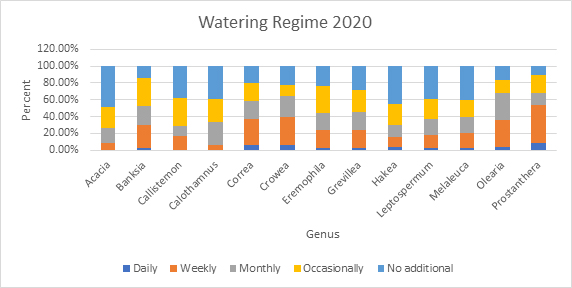
Respondents were then asked about the water needs of major genera in 2020 compared to usual water needs in a ‘normal’ summer. These answers were scored on a scale from 1 (needed a lot less water) up to 5 (needed a lot more water), with 3 being ‘no change’ — the results of this are shown in the graph below. Anything scoring 3 or higher needed more water in 2020 — that is, all genera. The results are shown in the graph below. Those that needed the most additional water were Prostanthera, Banksia, Olearia and Correa. Those that needed the least additional water were Hakea, Acacia, Calothamnus, Callistemon, Melaleuca, Leptospermum and Eremophila.

Changes to watering
Respondents were asked whether their strategy had changed over the 2020 season in response to external factors including the threat of fire over the season. Sixty nine percent of respondents made no changes to their watering strategy in response to these factors. However, 13% increased their watering to try to increase ‘green’ vegetation (for fire resistance), 4% used less water in order to save it for firefighting, a further 4% used less water because of the cost, and 10% took other approaches — (less) to conserve water for home use, or (more) to keep young plants alive.

The Impact of Heat
The survey asked respondents to comment on the impact of heat on different genera, as far as they could distinguish that from the effect of lack of rain. Limitations of the survey format meant we could only ask about main impacts and the final question asked about ‘no effect or couldn’t tell’. Hence, this analysis only includes those responses where a person could distinguish the impacts of heat separate to impacts of dryness.
As far as respondents could tell, those genera most resistant to heat were Calothamnus, Leptospermum and Banksia. Those least resistant to heat were Correa, Prostanthera and Olearia.
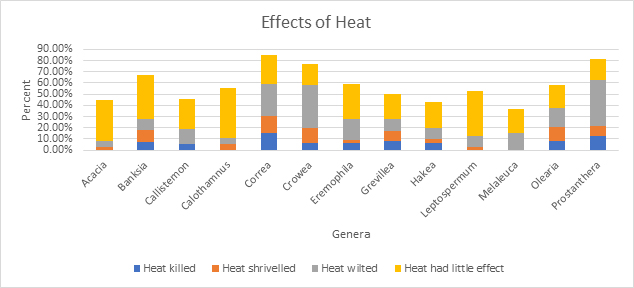
Shade
Respondents were asked if they provided extra shade to their plants last summer in order to protect them. The answer was a resounding ‘no’ with 33 of the respondents (63%) reporting no provision of extra shade last summer. However, many of those mentioned that they already had a partly shaded garden due to overhead cover (eg, from Eucalypts) and the shade provided by tall established shrubs, and the house itself for part of the day.
Those who did provide additional shade did so selectively (eg, to a particular plant which seemed to suffer a lot), to small plants, or to recent plantings. Protection included shade-cloth over the top, and plant protectors around the plants themselves. Some mentioned providing shade to the roots, rather than the top of their plants (eg, cooling roots of Boronia sp. by placing pebbles around the plant).
Plants in Pots
A separate set of questions was asked about plants in pots. Respondents were asked how they protected their pot plants in 2020 — 73% reported that they gave them more water, 51% reported they gave their pots more shade, and 16% gave their pots more insulation.
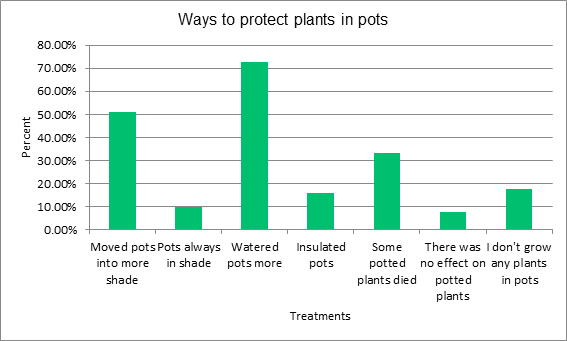
Lessons from 2020
A final set of questions asked about lessons from 2020. The first of these asked about genera respondents would not grow again because of the way they performed in 2020. It should be noted that one third of respondents reported that the 2020 experience had not changed their preference for any genera — they would grow all (of those listed) again and would adapt their watering and protection regimes after learning what worked during 2020. Of those who did nominate genera the most mentioned genera were Correa, Banksia, Prostanthera, Grevillea and Hakea.

Respondents also made many comments on this question, for example some would not grow any plants whose label said they needed moist soils/positions. Many noted the importance of mulching. Some recommended pruning before summer (to reduce the stress on the plant).
Respondents were also asked about other genera which they considered drought hardy, and which had not been listed in the earlier questions (which covered only the most frequently grown genera). Thirty-six respondents answered this question and recommended a long list of over 70 species. Those mentioned more than once are shown in the graph below.
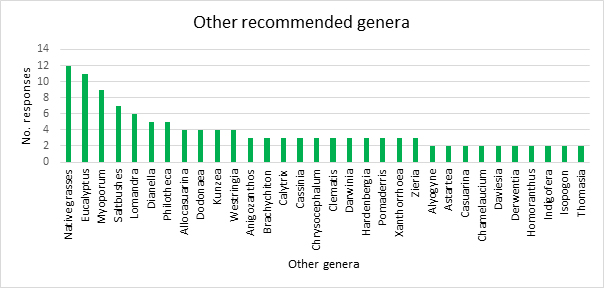
General comments
Finally, respondents were asked to comment about anything else. They noted:
- The hailstorm in January and bushfire smoke complicated their response to the hot summer;
- Many used shower and dish water to provide additional water to plants;
- Some plants that ‘died’ during the season have resprouted (eg, Hakea, Correa, Alyogyne);
- Many water new plants until they are ‘established’ and then stop — this could not be accounted for in the survey and may have affected results in relation to watering regimes;
- Extra leaf or chip mulch (eg, arborist chips[1] which vary in size, rather than bark or eucamulches which are uniform size) helped many plants survive;
- When hot days are predicted, provide extra water beforehand
- Ensure that, when planting, the hole is wide and deep so the plants can establish under prevailing conditions and limit extra watering
- Grey water can damage plants even when low-phosphorus detergent is used (Correa and Myoporum were mentioned here as suffering when grey water was used)
- Less frequent, deep watering helps plants survive stress more than frequent watering which encourages shallow rooting. Some had drain systems established so water went deeper into the soil;
- Some (desperate) wildlife ate plants that had not been eaten before;
[1] https://www.arboroperations.com.au/wp-content/uploads/2014/08/Arborist-Woodchip-as-Mulch_final-doc-.pdf
- More established plants fared better — some recommend delaying planting until Autumn, so plants have more time to establish before the next summer.
Discussion and Conclusions
A short, written survey cannot hope to address all the variability experienced by ANPS Canberra members over the 2020 summer. However, some lessons emerge:
Firstly, every garden is different and those genera which survived in one garden were stressed in another. This is not unexpected and is what made designing the survey somewhat difficult, but we all know as gardeners that we need to take our own conditions into account, and our neighbour can grow things that we can’t (and vice versa).
Secondly, respondents who had set about establishing a garden which did not receive additional water were pleased with how well their garden had survived or had recovered after the 2020 summer. These gardeners mentioned things like deep watering as a means to encourage plants to root deeply and hence not be so fazed by long hot spells (or short ones, as we had recently). Soil and its water retention, shade, and the age of the plantings also play a large part in the ability of these gardens to withstand heat and dry. The genera which needed the least additional water—Acacia, Callistemon, Hakea, Calothamnus and Melaleuca — were not a surprise and generally have the sort of foliage that you can just tell will withstand the dry. Similarly, those nominated as suffering least in the 2020 summer—Hakea, Acacia, Calothamnus, Callistemon, Melaleuca, Leptospermum and Eremophila — were not unexpected.
Thirdly, it was interesting to note that the dry conditions didn’t trigger a wholesale increase in watering — there was a very slight shift towards rescue watering (whoops — something looks like it needs water!) but generally people stuck with their existing watering regime. This was partly due to habit but concern about needing greener surrounds when there are fires threatening played a small part, as did the need to ensure that plants placed in spring could survive the conditions when still not properly ‘established’.
We were more surprised about the genera nominated as suffering more in the 2020 summer: Prostanthera, Banksia, Olearia and Correa. We can see that these were nominated because their response to heat and dry is to droop (with the exception of Banksia, these were also nominated as the least resistant to heat). However, in our experience (including last summer) many will revive overnight and Prostanthera in particular can survive prolonged dry even if they do look pretty awful. Correa and Banksia, on the other hand, will probably die in the same conditions.
While some respondents are reluctant to grow certain genera again (eg, Correa, Banksia), there was general enthusiasm for learning from the experience and applying the lessons to gardens, regardless of genera grown. Our members are happy to continue to persevere with the less drought-hardy species, with extra care and knowledge going forward.
The survey, of course, could only cover so much and there is a long list of other potential genera which respondents felt could withstand the conditions that are coming with climate change. Native grasses, Eucalyptus and Myoporum topped the pops in relation to the most recommended. Of course, people need space to grow a Eucalypt, but the list contains plants of all sizes. These are all worth considering.

the least additional water.
We again thank all those members who contributed to the survey and we hope the findings are useful for members and the wider public in successfully maintaining a native garden into the future.
Back to Articles List
